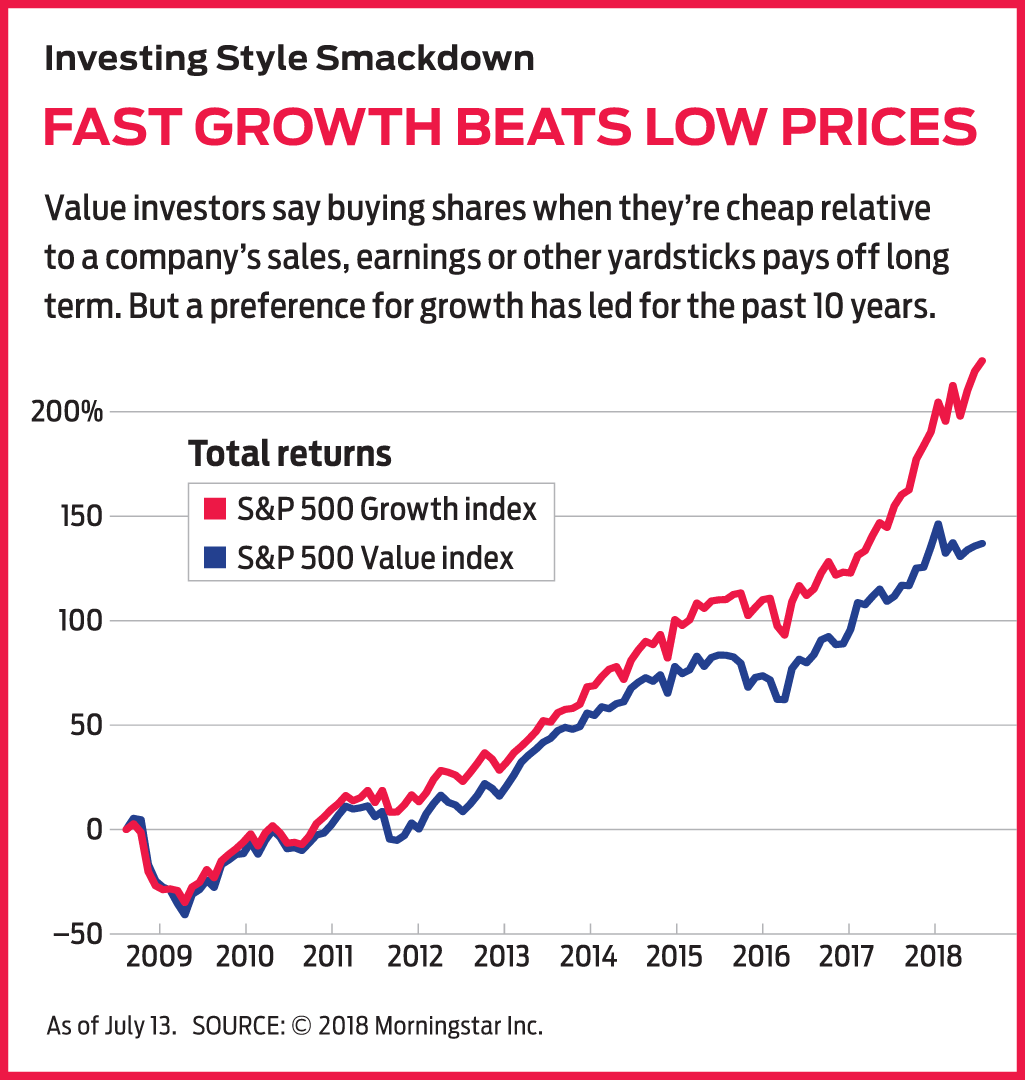Value Vs. Growth Stocks -- Which Will Come Out on Top?
Investors have shunned bargain-priced stocks in favor of fast growers for years. Is value due for a comeback?

Legends of investing, including Benjamin Graham and his disciple Warren Buffett, have long touted the advantages of value investing. Value stocks trade inexpensively compared with corporate measures such as sales, earnings and book value (assets minus liabilities). Historically, they have outperformed growth stocks, which boost earnings and sales faster than their peers. The thinking behind the value strategy is simple: Investors tend to bid up exciting, fast-growing companies to bloated levels and shun boring companies or those going through temporary problems.
When the market eventually comes to its senses and stock prices normalize, value wins. From July 1926 through May 2018, value stocks traded on U.S. stock markets outpaced growth stocks by an annualized 3.9 percentage points.
But for more than a decade, growth stocks have pummeled their bargain-priced counterparts. Since the beginning of the last bear market in 2007, Standard & Poor’s 500 Value index, which tracks value-oriented components of the broad market barometer, has returned a cumulative 77%, compared with a 179% return in the corresponding growth-stock yardstick. The walloping hasn’t been consistent; value outpaced growth in 2012 and 2016. Led by a still-booming tech sector, growth stocks in the S&P 500 have returned 11.6% so far in 2018, compared with 0.2% for value stocks. (Prices and other data are through July 13.)
From just $107.88 $24.99 for Kiplinger Personal Finance
Become a smarter, better informed investor. Subscribe from just $107.88 $24.99, plus get up to 4 Special Issues

Sign up for Kiplinger’s Free Newsletters
Profit and prosper with the best of expert advice on investing, taxes, retirement, personal finance and more - straight to your e-mail.
Profit and prosper with the best of expert advice - straight to your e-mail.
Growth stocks usually sparkle in bull markets, but value shares tend to shine in down markets. At least that was the case between 1970 and 2006. When the stock market dropped 55% in the financial crisis and associated bear market of 2007–09, value should have shone. Except that value-oriented financial firms were at the heart of the mess, and lost 82% over the period. From June 2014 to January 2016, energy stocks, also value stalwarts, lost 42% as oil prices plummeted.
At 11 years, value’s current slump is the longest ever—“an extreme outlier,” says Scott Opsal, research director at the Leuthold Group, a market research and money management firm in Minneapolis. So investors are right to ask: Is value investing down for the count? Or is now the time to seize opportunities in a group of stocks poised to get off the mat?
Rebound Ready
The trends favoring growth have shown few signs of slowing down this year. But today’s environment favors a rebound in value stocks, say many analysts. For starters, whereas stocks of fast-growing companies are most attractive when profits and economic growth are scarce, bargains present better prospects when overall growth accelerates. Today, Wall Street analysts expect corporate profits to rise an average of 22% in 2018, up from 12% last year; Kiplinger estimates 2.9% gross domestic product growth this year, up from 2.3% in 2017.

And although value stocks nearly always look cheaper than growth stocks, the discount today is particularly steep. Despite forecasts of similar levels of earnings gains for growth and value stocks, the S&P 500 Growth index trades at 21 times investment research firm S&P Capital IQ’s estimated 2018 earnings, on average, compared with a price-earnings ratio of 14.5 for the Value index. The 45% premium is well above the post-technology-bubble average of 28%.
Finally, rising short-term interest rates are also thought to benefit value stocks—particularly financial firms, which can reap more on their investments. Although today’s still-low long-term rates offer limited lending profits for the group, continued deregulation is in their favor. With these factors in mind, John Lynch, chief strategist at investment firm LPL Financial, says value is poised for a comeback.
Timing such cycles is difficult. But it’s a good idea to diversify your portfolio with the complementary styles of growth and value. Investors who already do this might find now an opportune time to rebalance. Consider: Someone who started with an equal amount invested in the S&P 500 Growth and Value indexes 10 years ago would now have 58% of assets in growth and 42% in value.
Great Values
Low-cost ETFs are an inexpensive, easy way to add value stocks to your portfolio. The SPDR S&P 500 Value ETF (symbol SPYV, $30) tracks its namesake index. The fund holds 384 stocks and charges an expense ratio of 0.04%. Top holdings include Berkshire Hathaway, JPMorgan Chase and ExxonMobil. Invesco S&P 500 Pure Value ETF (RPV, $67), with an expense ratio of 0.35%, tracks a limited version of the index featuring only stocks that rank in the bottom third of the S&P 500 by market size and that score high marks for value. Top holdings include CenturyLink and Kohl’s.
For a more targeted approach, consider Kiplinger ETF 20 member Invesco Dynamic Large-Cap Value (PWV, $36). The ETF charges 0.56% of assets and screens holdings for 10 factors, including quality and favorable share-price and earnings trends. The resulting 50-stock portfolio is full of blue chips, such as Procter & Gamble, Coca-Cola and Walt Disney.
Among actively managed funds, consider Dodge & Cox Stock (DODGX), a member of the Kiplinger 25, the list of our favorite no-load funds. The fund’s contrarian managers buy into fundamentally strong businesses whose shares are underpriced because of negative investor sentiment or unfavorable market environments. T. Rowe Price Value (TRVLX) invests in stocks that trade at a discount to historical averages, shares of their peers or the broad market. Both funds sport 15-year returns that place them among the top 13% of large-company value funds over that period.
Comanagers Stephen Yacktman and Jason Subotky at AMG Yacktman Focused Fund (YAFFX) home in on high-quality stocks trading on the cheap, favoring firms with robust free cash flow (cash profits left over after capital outlays) and little exposure to swings in the economy. An insistence on quality has bolstered returns during down markets. The fund, which at last check held only 22 stocks, lost 11.3% in the 2011 stock market correction, compared with an 18.6% decline in the broad market. Top holding: 21st Century Fox, Class B.
Boston Partners All Cap Value (BPAVX) has also proved its mettle during down markets. Manager Duilio Ramallo’s decision to lighten up on financial stocks paid off in 2008. The fund’s 27.6% loss that year beat the S&P 500 by 9.4 percentage points and placed it among the top 4% of large-company value funds. Today, financial stocks are back in the fund’s good graces: JPMorgan Chase, Bank of America and Citigroup are three of the fund’s top four holdings. The fund is also bullish on old-school tech, including Cisco Systems and Oracle.
Successful value investors share a common trait: patience. For those who can wait long enough, the strategy will pay off, says Leuthold’s Opsal. “At some point, the great growth winners of this bull market are going to run out of gas and people are going to get tired of overlooking consumer staples, financials and energy shares. The timing is not something you can put your finger on,” he says, “but there are a lot of ways for value to win.”
Profit and prosper with the best of Kiplinger's advice on investing, taxes, retirement, personal finance and much more. Delivered daily. Enter your email in the box and click Sign Me Up.

Ryan joined Kiplinger in the fall of 2013. He wrote and fact-checked stories that appeared in Kiplinger's Personal Finance magazine and on Kiplinger.com. He previously interned for the CBS Evening News investigative team and worked as a copy editor and features columnist at the GW Hatchet. He holds a BA in English and creative writing from George Washington University.
-
 December Fed Meeting: Live Updates and Commentary
December Fed Meeting: Live Updates and CommentaryThe December Fed meeting is one of the last key economic events of 2025, with Wall Street closely watching what Chair Powell & Co. will do about interest rates.
-
 This Is Why Investors Shouldn't Romanticize Bitcoin
This Is Why Investors Shouldn't Romanticize BitcoinInvestors should treat bitcoin as the high-risk asset it is. A look at the data indicates a small portfolio allocation for most investors would be the safest.
-
 I'm a Federal Benefits Pro: I Answer These 2 Questions a Lot
I'm a Federal Benefits Pro: I Answer These 2 Questions a LotMany federal employees ask about rolling a TSP into an IRA and parsing options for survivor benefits, both especially critical topics.
-
 Stocks Keep Climbing as Fed Meeting Nears: Stock Market Today
Stocks Keep Climbing as Fed Meeting Nears: Stock Market TodayA stale inflation report and improving consumer sentiment did little to shift expectations for a rate cut next week.
-
 Small Caps Hit a New High on Rate-Cut Hope: Stock Market Today
Small Caps Hit a New High on Rate-Cut Hope: Stock Market TodayOdds for a December rate cut remain high after the latest batch of jobs data, which helped the Russell 2000 outperform today.
-
 UNH Sparks a 408-Point Surge for the Dow: Stock Market Today
UNH Sparks a 408-Point Surge for the Dow: Stock Market TodayThe best available data right now confirm both a slowing employment market and a December rate cut, a tension reflected at the equity index level.
-
 Stocks Bounce Back With Tech-Led Gains: Stock Market Today
Stocks Bounce Back With Tech-Led Gains: Stock Market TodayEarnings and guidance from tech stocks and an old-school industrial lifted all three main U.S. equity indexes back into positive territory.
-
 Dow Slides 427 Points to Open December: Stock Market Today
Dow Slides 427 Points to Open December: Stock Market TodayThe final month of 2025 begins on a negative note after stocks ended November with a startling rally.
-
 Stocks Extend Win Streak on Black Friday: Stock Market Today
Stocks Extend Win Streak on Black Friday: Stock Market TodayThe main indexes notched wins in Friday's shortened session, with the blue-chip Dow Jones Industrial Average closing higher on the month.
-
 Dow Adds 314 Points to Thanksgiving Rally: Stock Market Today
Dow Adds 314 Points to Thanksgiving Rally: Stock Market TodayInvestors, traders and speculators enjoy the best Thanksgiving Week gains for the major stock market indexes in more than a decade.
-
 Dow Gains 664 Points as Rate-Cut Hopes Rise: Stock Market Today
Dow Gains 664 Points as Rate-Cut Hopes Rise: Stock Market TodayMarkets are pricing in higher odds for a December rate cut, fueling a major rally in stocks ahead of the Thanksgiving holiday.